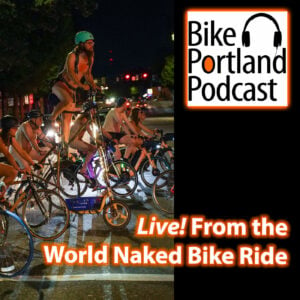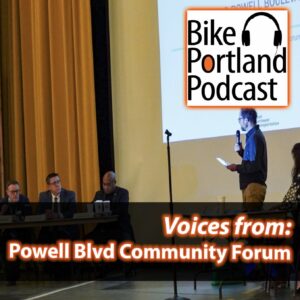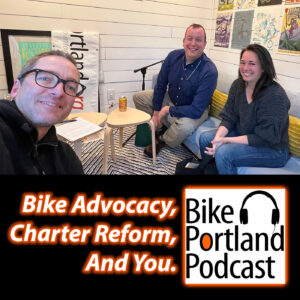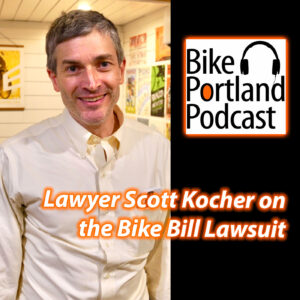
And other speculative but interesting scenarios.
(Photo: J.Maus/BikePortland)
We spend all our time on this website writing about things that are true.
So we decided that it’d be fun to spend 40 minutes talking about things that aren’t.
In the latest episode of our monthly podcast, producer Lillian Karabaic, Jonathan and I sat down for a particularly fun game: inspired by this CityLab post, we took turns proposing improbable (but plausible) events that could change the future of Portland transportation and then making educated (though sometimes wacky) guesses about what would happen next.
We considered scenarios like these:
Advertisement
What if Walmart started selling commuter-quality bikes?
What if the city held its public meetings after its street projects instead of beforehand?
What if we removed every street parking space in the city overnight?
We spent a few minutes on each of these and other possibilities. And the ideas did my favorite thing that ideas can do: ricochet.
One annoying note: Due to a problem with my microphone, I’m at a much lower volume here than Jonathan and Lily. Listening with headphones helps. We apologize for this and will get it straightened out for the next episode.
You can subscribe to our monthly podcast with Stitcher or iTunes, subscribe by RSS, sign up to get an email notification each time we upload a new episode, or just listen to it above using Libsyn.





Thanks for reading.
BikePortland has served this community with independent community journalism since 2005. We rely on subscriptions from readers like you to survive. Your financial support is vital in keeping this valuable resource alive and well.
Please subscribe today to strengthen and expand our work.
What if the City cracked down on bike theft?
What if the DA cracked down on bike thieves?
Good episode. But, what if everyone listened?
What if we could toll all the out of town drivers?
(No, I did not listen.)
Like it. Bridge tolls for the biggest to the smallest vehicles. Big trucks and Trimet buses that pollute the most would pay the most.
Disturbingly the big trucks and the Trimet buses all have fairly strict emissions controls. If you want to see/smell the dirtiest Trimet vehicle get behind one of the LIFT buses.
They are Ford E350’s and they are legally “full sized vans” not commercial vehicles. Obviously this allows some regulatory leeway in regards to tailpipe emissions.
Tolls should be by weight as that is what damages transportation infrastructure.
Except that transit and refuse collection vehicles traditionally have been exempt from the weight restrictions (hence the Novick desire for a new bus design with more rear wheels).
In theory a passenger bus takes a larger tonnage of SOVs off the the road than it replaces. Let’s pretend this is an undisputed fact always.
AASHTO’s “Generalized Fourth Power Law” states that “the damage caused by a particular load is roughly related to the load by a power of four” so if I have a fully loaded bus and an equivalent tonnage of “evil” Hummers the bus will cause more road wear.
2 problems:
(1) on average the tonnage removed by a bus should more than compensate for this. The Gillig model bus (CNG model; GVW hard to find) curb weight is around 29,000lb, GVW just under 40,000lb. Removing just 20 average American passenger vehicles is covers 40,000lb with a margin.
(2) more axles means the load is spread out to causing less road wear.
Remember: road wear is less about total vehicle weight than the weight imparted to the road surface at the heaviest axle. If there are more axles then the weight is distributed more evenly, less road damage occurs, less maintenance is required and less money needs to be collected for repairs.
More axles to distribute load weight IS NOT a tax dodge: it is responsible commercial freight hauling. More complex equipment is more expensive
As for pollution:
I guarantee those LIFT buses are some the worst government vehicles in Portland.
I have the “special” good fortune to have a upper respiratory/sinus condition that makes me hyper-sensitive to pollutants (combustion byproducts, artificial fragrances, VOCs) in the form of screaming migraine headaches.
Driving a truck long haul as I do up the I-5 through Grants Pass I get to experience their dirty air on a weekly basis. Sadly, now I can guess the Official AQI pretty closely based on the quality of my pain.
Those E350 Ford van conversion buses are not being monitored or are exempted from DEQ.
I can’t speak to legal exemptions for neighborhood trash collection vehicles (though they would DEFINITELY qualify as commercial vehicles) but I have not encountered any in Portland in the last decade that have given me pain.
And bikes too, I assume.
Defintely.
A base minimum for space taken up on the road/bridge
PLUS
a weight charge for road wear caused the vehicle in question.
Obviously a bicycle takes up some space in a roadway.
Much less than a car, a passenger truck, buses or freight trucks.
Congestion pricing is based on physical presence on the facility, not weight.
The actual cost imposed by a vehicle on the taxpayer is determined entirely by weight.
You show me ANY evidence that bicycles are causing ANY road wear on paved surfaces and we will pay our fair share {hmmm … actually why couldn’t that apply to unpaved dirt trails in sensitive nature areas?}
Perhaps Copenhagen has some evidence of bicycle cause road damage?
The larger of the two charges should be the weight fee if we are concerned with not under-funding our transportation department.
If congestion demand shaping is our goal then the vehicle use fee would need to increase in the high demand times; during low demand it should be almost nothing as an incentive to travel then not during rush hour.
I’ll throw in my two cents.
Because that would be about the appropriate toll for bicycles.
Thank you Fozzy Bear!
Randy,
First, define ‘pollute the most’. Emmissions per hour? gallon consumed? how about per passenger mile? And, isn’t a fuel/carbon tax a good way to charge such a fee?
Second, with what goals in mind? An SOV that is hybrid. or electric, takes up about as much space as an SOV that uses an ICE exclusively. So, even if we work on reduced emmissions with such a tax, it may not reduce congestion.
When the haters got to whining recently about the new Tillikum Crossing being built without car facilities, I decided to count up the existing crossings. In central Portland alone, there are 43 lanes of traffic that are open to cars across Willamette River bridges.
If 43 lanes can’t handle all the rush-hour car traffic (as is frequently the case), then we obviously the resource is priced too low.
oops, forgot to close out the bold font. Sorry.
What if The DMV charged an extra $10 a person and put that towards educating drivers (especially new drivers!) Solely on the responsibilities and the must for safe, respectful and courtesy driving habits?
And also DMV makes every driver completely retest every 5 years (driving and written test)! and each 5 year renewal would be a specific section that progressively focuses on courteous driving habits and other road user safety?
A re-test every couple, or so, years should be one of the safety strings for federal funding. Just like the 0.08 = DUII.
No more multiple guess tests.
For the first month you have to have one of those driver monitor boxes plugged in to your vehicle like Progressive insurance offers for a lowered rate. The DMV checks it after 30 days.
SURPRISE! This was the new 30 day driving test.
() If you were a perfect driver you pass: no further issues.
() If you had any violations caught by the black box but no issued tickets you are on probation. Monitoring length is extended 90 day from now. If you pass with the next 90 days the monitoring device will be removed; if not your probationary driver’s licence will be extended for another 90 day period of mandatory monitoring.
() If you received a ticket within any monitoring period: You Fail! Licence revocation process begins.
Didn’t listen, but what if streets were designed and operated based on all of the road users, and not just some of the road users?
Having spent more time than usual as a pedestrian this fall, here’s one that’s sticking in my craw:
What if we banned “Beg Buttons” for pedestrians at stoplights?
So, stop Barbur, or 122nd, or 102nd, or Stark, or Division long enough for a pedestrian to cross (distance/3 + 3 sec) at every signalized intersection every time the light changes 24/7, regardless of how many pedestrians are waiting?
Wouldn’t a more efficient solution be to have a minimum time once a button is pushed, and have it increase up to some upper limit for successive pushes, crossing District Collector or Major City Traffic streets only, but do eliminate such ped signal buttons on signalized intersections of Neighborhood Collector and lower classified intersections?
Like the other “what ifs,” it’s more rhetorical than realistic. Tolling all the bridges is even less realistic.
But I can dream. Such a rule would incentivize engineers to create intersections that work better for pedestrians. They’d more aggressively employ various tools in the box to shorten often-excessive crossing distances. Replace more low-pedestrian-traffic rural intersections with roundabouts. Invent and deploy advance pedestrian detectors so that they wouldn’t have to engage the walk phase every cycle. (Besides, how come cars get advance detectors almost everywhere now, but as a pedestrian I don’t get to beg permission until AFTER I arrive at the intersection?) The desire to reduce crossing distances might even revive a discussion of banning long trucks from the central city so curb radii can be tightened.
I do like your suggestions, though. Even if we didn’t implement such a rule, its discussion might trigger more such ideas to improve the anti-pedestrian bias of our roadways.
Here’s another: If I hit the button just after the adjacent green phase has begun, I won’t get a WALK signal – even if it’s short (say, <40-60') crossing and adjacent car traffic ends up extending the green MUCH longer than the MUTCD crossing time. If arriving cars can extend the green, why can't pedestrians? I have had this happen OVER AND OVER again lately here in Beaverton. It can easily add 5+ minutes to a 2 mile walk.
Also, the beg-button doesn't recognize many pedestrians' desire to cross diagonally – which, in the car-heads' language, is the equivalent of making a simple right or left turn. So under the current regime, I hit both buttons, cross on whichever phase comes first, and sometimes find myself arriving at the next corner TOO LATE to activate the button for the adjacent crossing, and forced to wait an entire extra cycle. I'm not sure how to solve this problem other than the Barnes dance, but a regime that better honors my need to cross to the opposite corner, much as left-turning vehicles get protected phases, would be welcome.
Another approach would be to selectively ban the Beg Buttons under certain conditions: more minor roads as you suggested, or times of day when pedestrian traffic is significant. Maybe the rule would be that they are disabled (i.e., walk phase always activated) from 7am to 7pm. Or until 10pm in places with evening activity.
Agreed.
Portland should have more modern roundabouts (there are only 2 1/2 right now).
Hovenring! Great ‘cast this month. Maybe my favorite yet. Less process is definitely something we can dream of in Portland, especially on trial basis infrastructure projects. Lots of interesting ideas. Thanks.
What if: Portland became a city of extreme environmental wackos and outlawed cars AND bikes due to the resources and energy used to produce and operate them? And all the streets and parking spaces were used to grow food and pot for Porklanders!!! WHOA, DUDE!!!!
https://www.youtube.com/watch?v=J2-29SW61FQ
Can I have a horse? Or at least ride my milk cow?
Just found the Worst Beg Button Ever last night: a place where you must push the button for a WALK signal to cross a driveway that is blocked with metal bollards. And this is not out in the ‘burbs somewhere, but right in the inner Southeast Portland core.
I’d biked past it hundreds of times, but didn’t notice until last night when I was walking home from downtown, and there it was. The western sidewalk along Water Avenue, at the T-intersection with Clay Street.
http://goo.gl/maps/iDYLX
Oops, forgot to cancel the italics. Sorry.